Science & Environment
The Elements of Marie Curie review: Dava Sobel’s biography of Marie Curie shows how she helped women into science
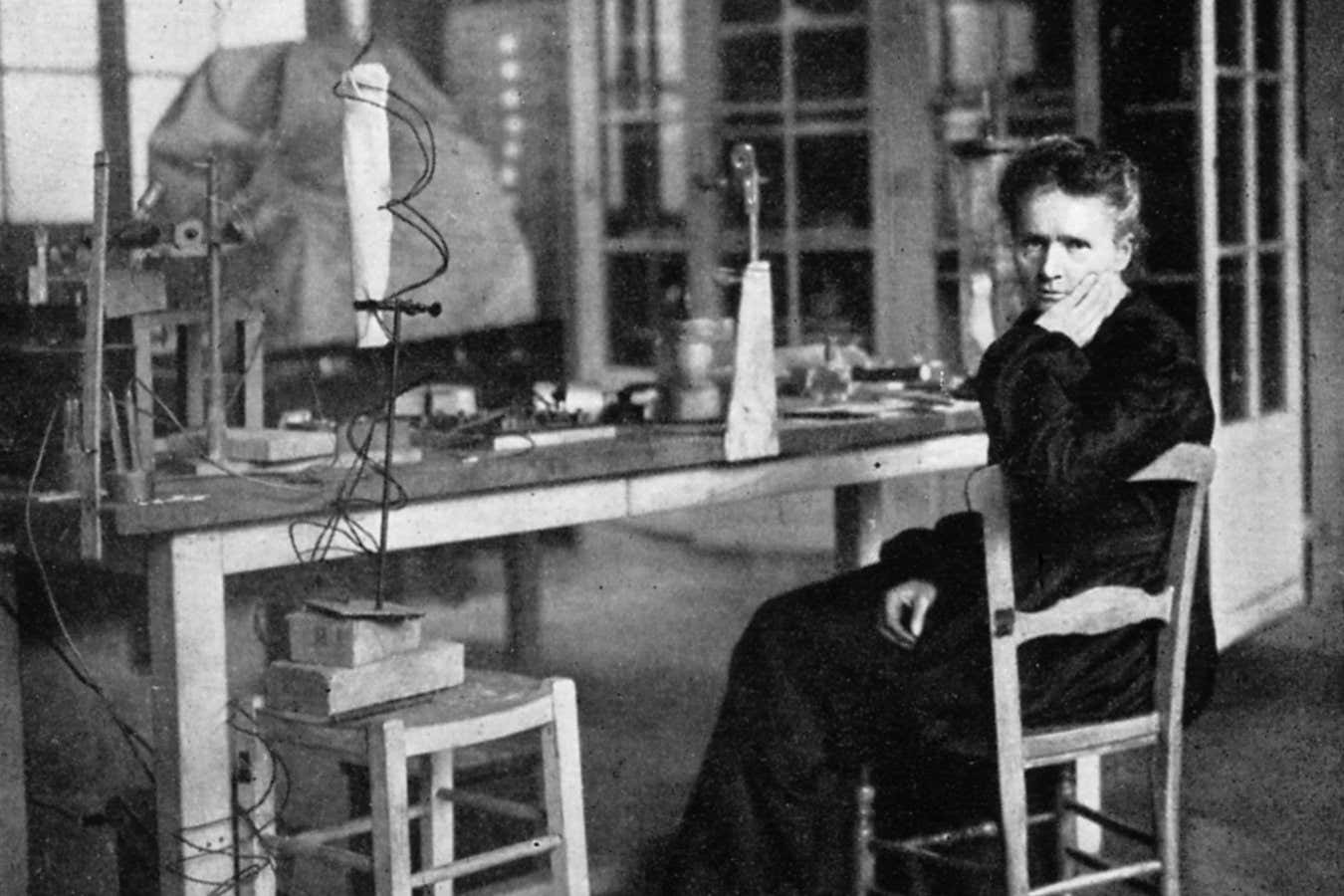

Marie Curie pictured at work in her laboratory in Paris, in 1912
Universal History Archive/Getty Images
The Elements of Marie Curie
Dava Sobel (Fourth Estate, UK; Grove Atlantic, US)
ON 7 November 1867, Marya Salomea Sklodowska was born in Warsaw, then part of the Russian Empire. She was the youngest of five children, and became known as “Manya” by her family.
She was a voraciously curious child who learned to read at the age of 4 and developed a fascination with science, thanks in large part to her father, a teacher of physics and mathematics. Even so, no one could…
Science & Environment
China’s steel exports expected to falter in 2025 as pain from tariffs spread
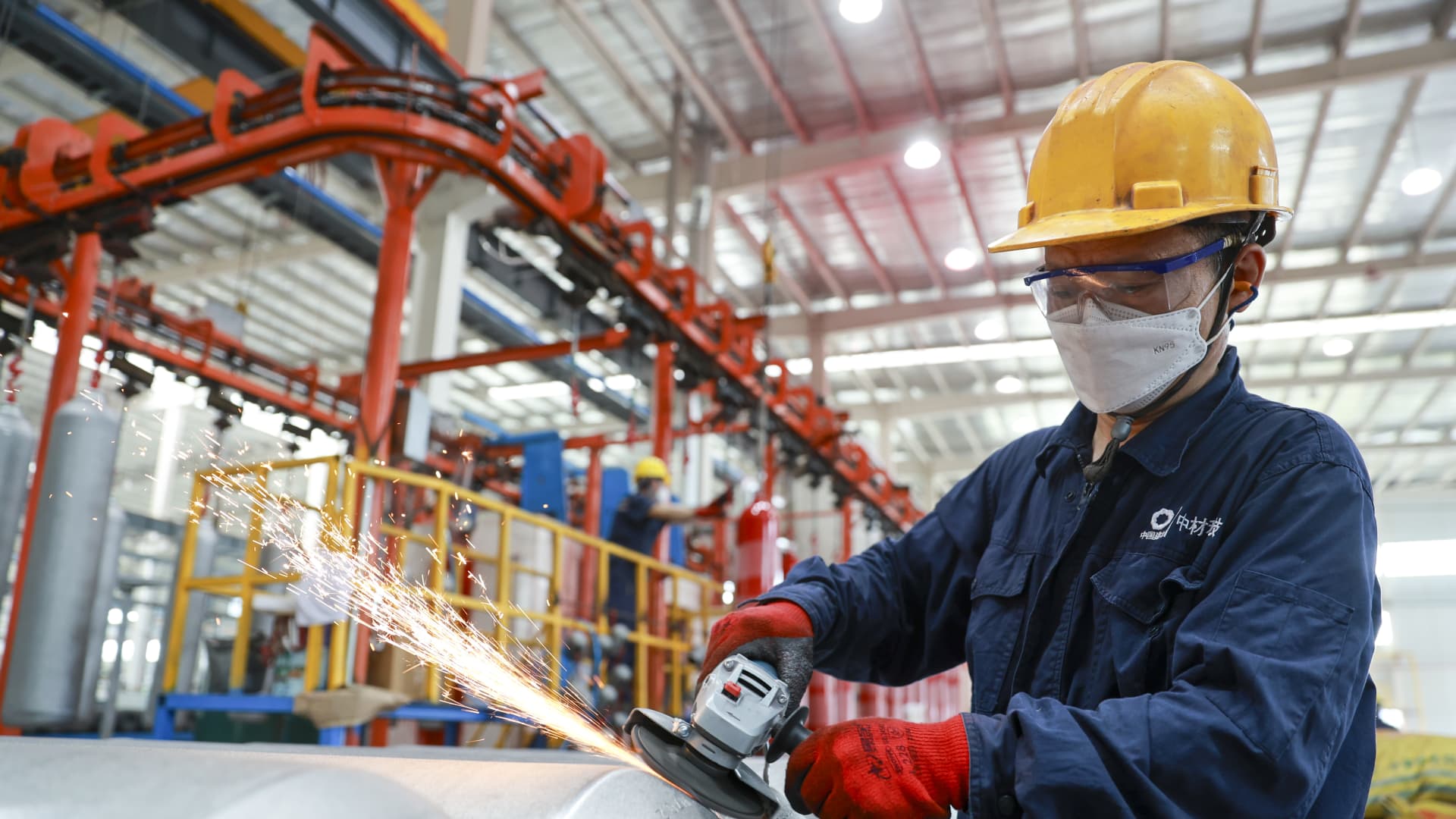
JIUJIANG, CHINA – JUNE 17: A worker manufactures seamless steel gas cylinders for export at the workshop of Sinoma Science & Technology (Jiujiang) Co., Ltd. on June 17, 2024 in Jiujiang, Jiangxi Province of China.
Wei Dongsheng | Visual China Group | Getty Images
China’s steel exports will soon hit an eight-year high, before sweeping tariffs sink in and drag down the industry in 2025, industry watchers said.
As the biggest exporter of steel, China accounts for about 55% of the world’s steel production. The country’s steel exports have been surging this year and are expected to smash through the 100 million metric ton mark, matching levels last seen in 2016.
Strategists at Macquarie Capital predicted that China’s steel exports will reach 109 million tons this year, before declining to 96 million tons in 2025. Trade tariffs could further curb China’s steel exports, “albeit this may require a while to play out,” analysts from the the investment bank told CNBC.
Their predictions were echoed by analysts interviewed by Citigroup. China’s steel shipment is “skewed to the downside” from next year and onwards due anti-dumping measures, Ren Zhuqian, an analyst from steel consultancy Mysteel, said in a Citigroup note this month.
Foreign markets have been particularly crucial amid a domestic supply glut, as China’s economy grapples with a prolonged property crisis and slowdown in manufacturing activities.
In September, China’s steel exports jumped 26% from a year ago to 10.2 million tons, surpassing the 10-million ton a month benchmark that was last hit in June 2016. In the first nine months of the year, exports rose 21.2% year on year to 80.7 million tons, according to the customs data last week.
After hitting a record high of 112 million tons in 2015, the country’s steel exports had been on a multi-year slide before it started improving in 2020.
Steel export growth has accelerated ever since, propelled by a lack of domestic demand, even as overall export growth in China slowed sharply in September on the back of a series of disappointing data that pointed to a weak economy.
Anti-dumping ‘Wac-A-Mole’
Floods of cheap steel from China had sparked concern among its trading partners of unfair competition for domestic steelmakers. More and more have ramped up anti-dumping measures, including hefty tariffs.
Steel producers in importing countries have been “under massive strain,” said Chim Lee, senior analyst at the Economist Intelligence Unit, especially those in Southeast Asia and the Middle East.
Thailand expanded anti-dumping duties to 31% on hot-rolled coil, high-strength steel used for critical infrastructure construction, from China in August. Mexico imposed a nearly 80% tariff on some Chinese steel imports late last year.
This month, Brazilian government imposed 25% tariffs on all steel products from the country. And Canada’s 25% surtax on Chinese steel products, which it announced in August, came into effect on Tuesday.
These kinds of protectionism measures tend to have short-lived impacts, said Tomas Gutierrez, head of data at consultancy Kallanish Commodities, as steel exporters resort to measures such as “circumvention,” shaking off the China-label by making transits through a third-party country.
We see a ‘whac-a-mole’ scenario: when one country starts to limit steel imports from China, Chinese steel producers are likely to redirect them to another country until that market, too, imposes new trade restrictions.
Chim Lee
Senior analyst, Economist Intelligence Unit
But Vietnam’s ongoing anti-dumping probe into hot-rolled coil could derail China’s export momentum as it “impacts a much higher volume of Chinese steel,” Gutierrez said.
Vietnam is a major importer of Chinese steel, consuming about 10% of the country’s steel exports in 2023, according to a Mysteel report. Other top destination markets include Thailand, India and Brazil.
Last month, Indian government ordered tariffs of between 12% and 30% on some steel products imported from China and Vietnam, escalating an anti-dumping duty it imposed on Chinese steels last year.
“We see a Whac-A-Mole scenario,” EIU’s Chim said. The tariffs lead Chinese steel producers to redirect to alternative markets, “until that market, too, imposes new trade restrictions.”
U.S. President Joe Biden’s administration called for tripling tariffs on Chinese steel in April, and Republican presidential nominee Donald Trump said he could raise tariffs by 60% on Chinese goods if re-elected next month.
But the impact of these threats from Washington would be rather limited, as less than 1 percent of Chinese steel exports, worth $85 billion, were shipped to the U.S. in 2023.

Dwindling demand
For the first time in six years, the World Steel Association this month forecast that China’s domestic steel demand this year would account for less than half of global demand, citing “the ongoing downturn” in the country’s real estate sector.
China’s property-related steel demand may not see a substantial improvement until 2025 or 2026, EIU’s Chim said, as Beijing seeks to curb new housing supplies while clearing existing housing inventories.
New construction starts, the most steel intensive part of the property construction process, will continue to be very weak, Chim said.
Meanwhile, he added, state-led infrastructure investment, which has increasingly pivoted away from roads and railways to energy infrastructure, is unlikely to fill the gap left by home builders.
More domestic steelmakers had scaled back production given poor profitability on steel sales. Almost three-quarters of Chinese steel companies reported losses in the first six months this year, with many at risks of bankruptcy.
China’s production of medium-thick hot-rolled coil — a proxy of flat steel products — fell 5.4% from the prior month in September, and 6.4% on year, according to S&P Global, which cited official customs data.
On escalating trade tensions, a spokesperson for China’s customs administration said a majority of Chinese steel products were to meet domestic demand, before receding that the hard-rolled coils “would have broad appeal in overseas market,” due to continuous innovation and product upgrades in the industry.
A possible tax crackdown
Beijing’s possible crackdown on value-added tax could make matters worse for China’s steel industry.
This year, steel mills have been under pressure from regulators over allegations that they skirted taxes to make exports even cheaper.
Authorities had set up an investigative team to crack down on these “illegal” steel exports, Luo Tiejun, vice president of the state-backed Iron and Steel Industry Association, said in a meeting last week.
“If China really followed through [with the investigation], Chinese exports would be much less competitive and export volumes could come down,” Gutierrez said. But the government may not have the “confidence” for that yet.
Science & Environment
‘consistent and coherent energy policy’ matters
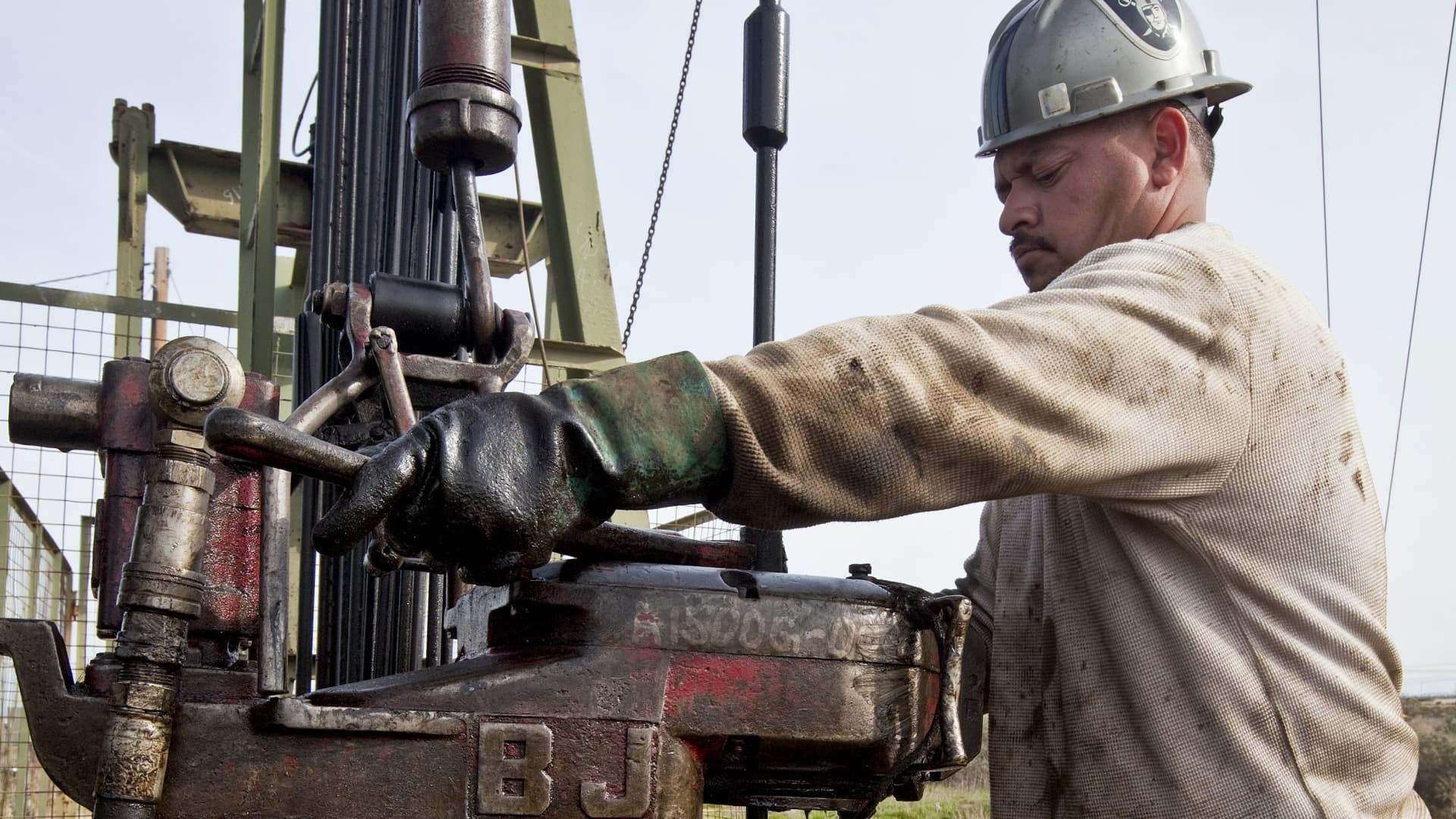
With a historic presidential election just around the corner, Chevron CEO Mike Wirth told CNBC’s Jim Cramer what kind of government action is important for his company.
“What really matters is consistent and coherent energy policy,” he said. “Affordable and reliable energy is essential to keeping inflation at a level that economies can handle — and that’s why we need investments, and we need stable policy to encourage that investment.”
Wirth stressed that energy is a vital part of the global economy, saying that if supplies are constrained by political actions, it can trigger inflationary reactions across the board. The price of energy, he continued, is “embedded in everything,” and he said other countries are looking to the U.S. for long term commitments about energy and investment in the global supply.
According to Wirth, Chevron is apolitical and tries to work with both parties. He said there are legislators from both sides of aisle — usually from energy producing states — that understand his company’s needs. He said Chevron wants to see people elected to office that believe in free markets, competition and “the economic vitality of this country.”
He also stressed that electricity demand in the U.S. will continue to grow, saying there will be a need for all kinds of power, including wind, solar and natural gas. He added that even though electric vehicles are becoming more popular, combustion engines remain important and produced en masse. And Chevron’s oil has purposes beyond gasoline, he continued. For example, he said, oil helps create petrochemicals which are used for a variety of manufacturing purposes, including to create materials for EVs.
“There’s room for all of it. We’re going to need all of it,” he said, “I want to see every solution that is economic and feasible come to bear.”
Science & Environment
What happened when a rock as big as London hit Earth?
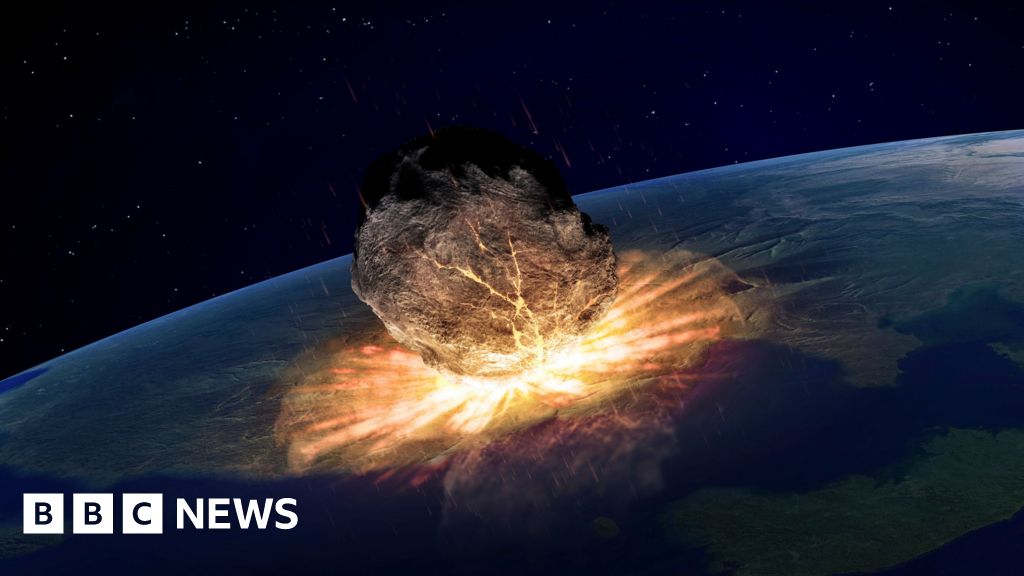
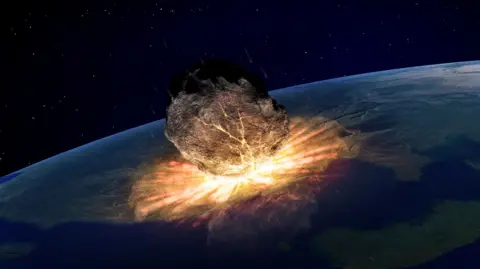 Getty Images
Getty ImagesA huge meteorite first discovered in 2014 caused a tsunami bigger than any in known human history and boiled the oceans, scientists have discovered.
The space rock, which was 200 times the size of the one that wiped out the dinosaurs, smashed into Earth when our planet was in its infancy three billion years ago.
Carrying sledge hammers, scientists hiked to the impact site in South Africa to chisel off chunks of rock to understand the crash.
The team also found evidence that massive asteroid impacts did not bring only destruction to Earth – they helped early life thrive.
“We know that after Earth first formed there was still a lot of debris flying around space that would be smashing into Earth,” says Prof Nadja Drabon from Harvard university, lead author of the new research.
“But now we have found that life was really resilient in the wake of some of these giant impacts, and that it actually bloomed and thrived,” she says.
The meteorite S2 was much larger than the space rock we are most familiar with. The one that led to the dinosaurs’ extinction 66 million years ago was about 10km wide, or almost the height of Mount Everest.
But S2 was 40-60km wide and its mass was 50-200 times greater.
It struck when Earth was still in its early years and looked very different. It was a water world with just a few continents sticking out of the sea. Life was very simple – microorganisms composed of single cells.
 Nadja Drabon
Nadja DrabonThe impact site in Eastern Barberton Greenbelt is one of the oldest places on Earth with remnants of a meteorite crash.
Prof Drabon travelled there three times with her colleagues, driving as far as possible into the remote mountains before hiking the rest of the way with backpacks.
Rangers accompanied them with machine guns to protect them against wild animals like elephants or rhinos, or even poachers in the national park.
They were looking for spherule particles, or tiny fragments of rock, left behind by impact. Using sledge hammers, they collected hundreds of kilograms of rock and took them back to labs for analysis.
Prof Drabon stowed the most precious pieces in her luggage.
“I usually get stopped by security, but I give them a big spiel about how exciting the science is and then they get really bored and let me through,” she says.
 Nadja Drabon
Nadja DrabonThe team have now re-constructed just what the S2 meteorite did when it violently careened into Earth. It gouged out a 500km crater and pulverised rocks that ejected at incredibly fast speeds to form a cloud that circled around the globe.
“Imagine a rain cloud, but instead of water droplets coming down, it’s like molten rock droplets raining out of the sky,” says Prof Drabon.
A huge tsunami would have swept across the globe, ripped up the sea floor, and flooded coastlines.
The 2004 Indian Ocean tsunami would have paled in comparison, suggests Prof Drabon.
All that energy would have generated massive amounts of heat that boiled the oceans causing up to tens of metres of water to evaporate. It would also have increased air temperatures by up to 100C.
The skies would have turned black, choked with dust and particles. Without sunlight penetrating the darkness, simple life on land or in shallow water that relied on photosynthesis would have been wiped out.
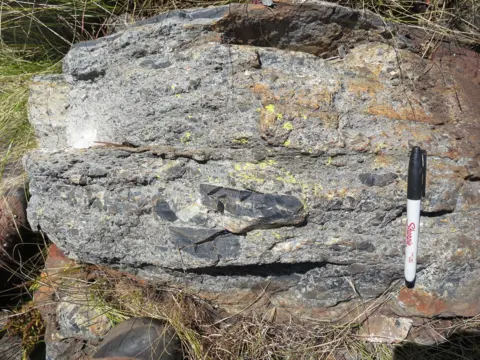 Nadja Drabon
Nadja DrabonThese impacts are similar to what geologists have found about other big meteorite impacts and what was suspected for S2.
But what Prof Drabon and her team found next was surprising. The rock evidence showed that the violent disturbances churned up nutrients like phosphorus and iron that fed simple organisms.
“Life was not only resilient, but actually bounced back really quickly and thrived,” she says.
“It’s like when you brush your teeth in the morning. It kills 99.9% of bacteria, but by the evening they’re all back, right?” she says.
The new findings suggest that the big impacts were like a giant fertiliser, sending essential ingredients for life like phosphorus around the globe.
The tsunami sweeping the planet would also have brought iron-rich water from the depths to the surface, giving early microbes extra energy.
The findings add to a growing view among scientists that early life was actually helped by the violent succession of rocks striking Earth in its early years, Prof Drabon says.
“It seems that life after the impact actually encountered really favourable conditions that allowed it to bloom,” she explains.
The findings are published in the scientific journal PNAS.
Science & Environment
Polar bears face higher risk of disease in a warming Arctic
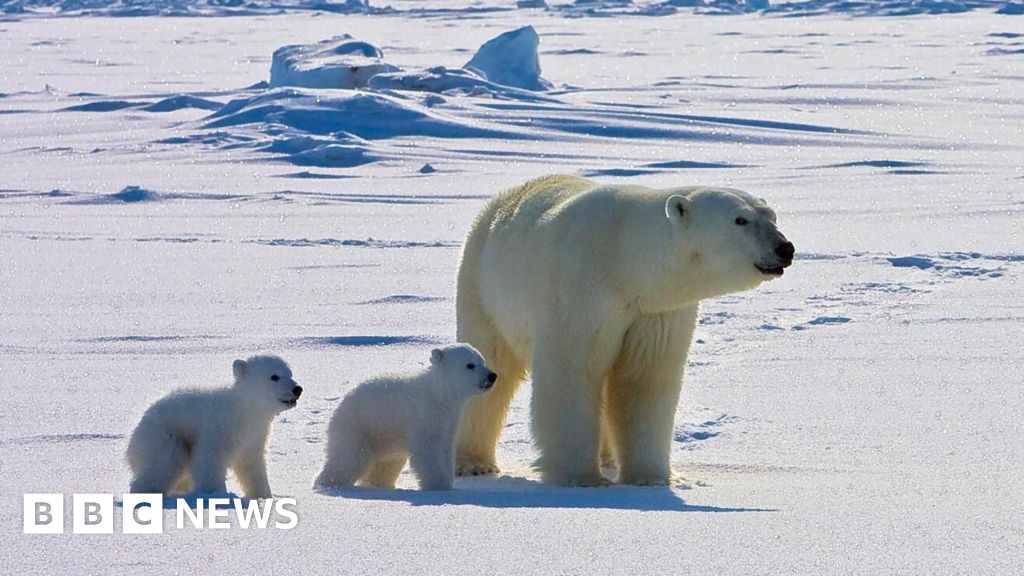
 USGS
USGSAs the Arctic warms, polar bears face a growing risk of contracting viruses, bacteria and parasites that they were less likely to encounter just 30 years ago, research has revealed.
In a study that has provided clues about how polar bear disease could be linked to ice loss, scientists examined blood samples from bears in the Chukchi Sea – between Alaska and Russia.
They analysed samples that had been gathered between 1987 and 1994, then collected and studied samples three decades later – between 2008 and 2017.
The researchers found that significantly more of the recent blood samples contained chemical signals that bears had been infected with one of five viruses, bacteria or parasites.
 USGS
USGSIt is difficult to know, from blood samples, how the bears’ physical health was affected, but wildlife biologist Dr Karyn Rode from the US Geological Survey said it showed that something was changing throughout the whole Arctic ecosystem.
The researchers tested for six different pathogens in total – viruses, bacteria or parasites that are primarily associated with land-based animals but have been recorded before in marine animals, including species that polar bears hunt.
The study covered three decades, Dr Rode said, “when there had been a substantial loss of sea ice and there’s been increased land use in [this population of polar bears]”.
“So we wanted to know if exposure had changed – particularly for some of these pathogens that we think are primarily land-oriented.”
The five pathogens, as disease-causing agents are collectively called, that have become more common in polar bears, are two parasites that cause toxoplasmosis and neosporosis, two types of bacteria that cause rabbit fever and brucellosis, and the virus that causes canine distemper.
“Bears in general are pretty robust to disease,” explained Dr Rode. “It’s not typically been known to affect bear population, but I think what it just highlights is that things [in the Arctic] are changing.”
Key polar bear facts
- There are about 26,000 polar bears left in the world, with the majority in Canada. Populations are also found in the US, Russia, Greenland and Norway
- Polar bears are listed as vulnerable to extinction by the International Union for Conservation of Nature, with climate change a key factor in their decline
- Adult males can grow to be around 3m long and can weigh close to 600kg
- Polar bears can eat up to 45kg of blubber in one sitting
- These bears have a powerful sense of smell and can sniff out prey from up to 16km away
- They are strong swimmers and have been spotted up to 100km offshore. They can swim at speeds of around 10km per hour, due in part to their paws being slightly webbed
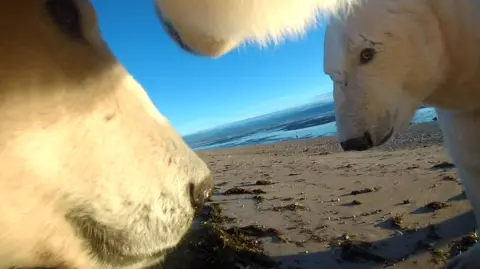 USGS
USGSIn the US, polar bears are classified as a threatened species; scientists say the biggest threat to their future is the continuing loss of sea ice habitat, which they depend on as a platform from which to pounce on their marine prey.
Previous research using collar cameras on bears has shown that, as they spend more of the year on land – when there is no available sea ice to hunt from – the bears are unable to find enough calories.
Dr Rode explained that polar bears are top predators: “Our study suggested that they’re getting their exposure to some pathogens primarily through their prey species.
“So what we saw as changes in pathogen exposure for polar bears is indicative of changes that other species are also experiencing.”
The findings are published in the scientific journal PLOS One.

Science & Environment
NextEra sees strong data center interest in restarting Iowa nuclear plant, CEO says

John Ketchum, chairman, president and chief executive officer of Nextera Energy, speaks during the 2023 CERAWeek by S&P Global conference in Houston, Texas, US, on Wednesday, March 8, 2023.
F. Carter Smith | Bloomberg | Getty Images
NextEra Energy is seeing strong interest from data center customers in restarting the Duane Arnold nuclear plant in Iowa, CEO John Ketchum said Wednesday.
“We are very busy looking at Duane Arnold,” Ketchum told investors during the company’s third-quarter earnings call. “We’re very interested in recommissioning the plant.”
NextEra is conducting engineering assessments on the plant and is working with the Nuclear Regulatory Commission and local stakeholders on evaluating a possible restart, the CEO said.
“Obviously, it goes without saying, there’s very strong interest from customers, really data center customers in particular around that site,” Ketchum said.
The CEO said in July that NextEra was weighing whether to restart Duane Arnold. He cautioned at the time, however, that the company would only do so if the project was “essentially risk free.”
The Duane Arnold Energy Center northwest of Cedar Rapids, Iowa ceased operations in 2020 after more than 40 years of service. The nuclear industry in the U.S. faced a wave of reactor shutdowns over the past decade as they struggled to compete against cheap natural gas.
But power companies are pressing ahead with restarting recently shuttered nuclear plants as electricity demand surges from data centers, manufacturing and the electrification of the economy.
Ketchum’s comments on Duane Arnold come a month after Constellation Energy unveiled plans to restart the Three Mile Island nuclear plant in Pennsylvania in 2028 through an agreement with Microsoft.
Tech giants such as Microsoft are grappling with massive power needs as they scale up artificial intelligence. Nuclear is attracting growing interest from tech companies because reactors provide large quantities of reliable, carbon-free power. Alphabet’s Google and Amazon recently announced investments in next-generation small nuclear reactors.
Holtec International, a privately held nuclear technology company, blazed the trail for restarting reactors with the Palisades plant in Michigan. Holtec expects that plant to come back online toward the end of 2025. It would be the first nuclear plant in U.S. history to restart after shutting down.
Science & Environment
Big Tech is driving a nuclear power revival, energy guru Dan Yergin says
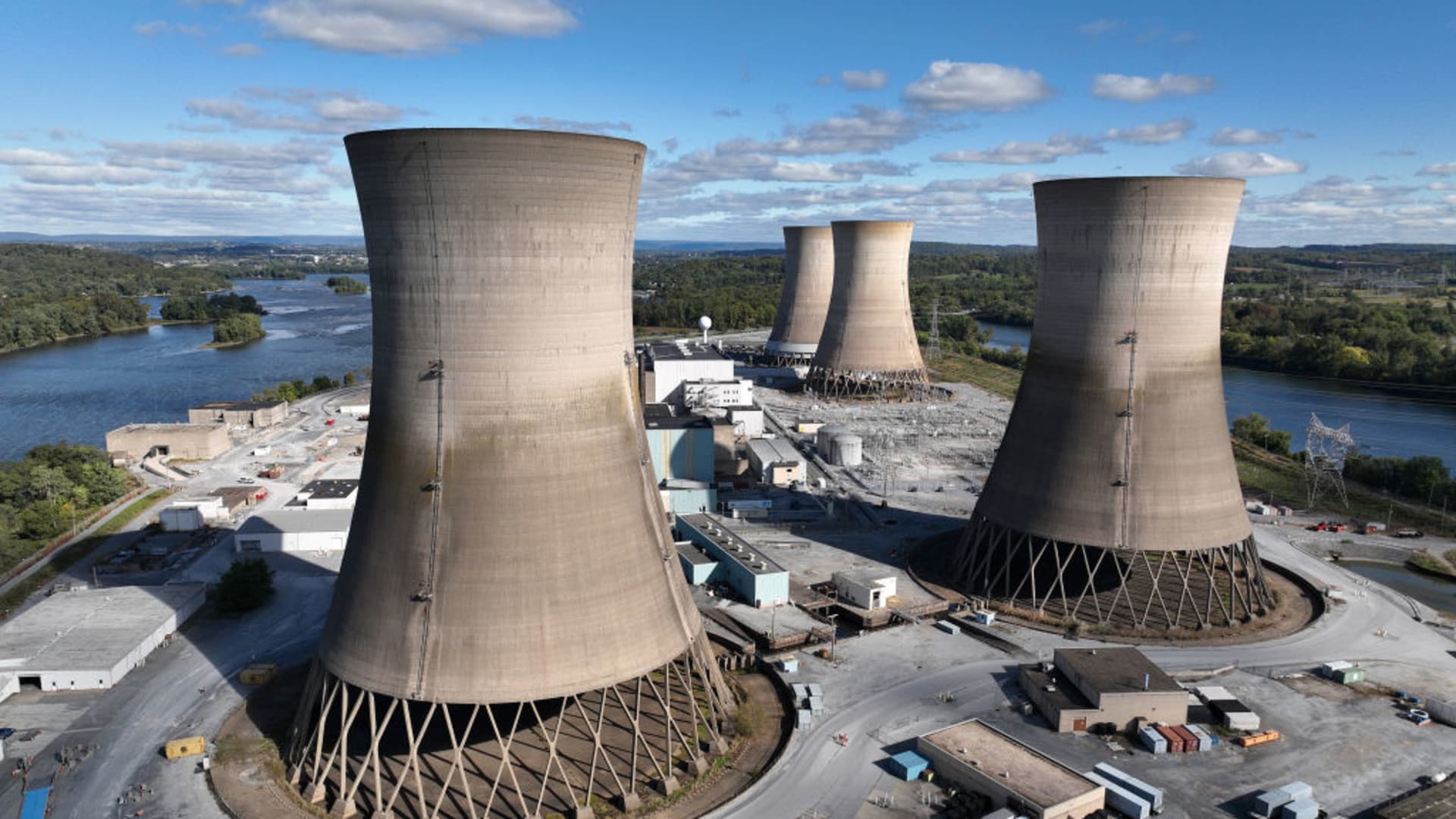
In this aerial view, the shuttered Three Mile Island nuclear power plant stands in the middle of the Susquehanna River near Middletown, Pennsylvania, on Oct. 10, 2024.
Chip Somodevilla | Getty Images
Nuclear power may be making a comeback in the U.S. after years of setbacks — and big tech is the driving force.
As tech giants like Microsoft, Amazon and Google compete to take the lead in the AI revolution, the data centers needed to power the burgeoning technology consume an ever-increasing amount of energy.
In the last two months, those three companies have penned deals to generate more nuclear power — perhaps most notably, Microsoft struck a 20-year agreement with Constellation Energy to restart a reactor at Three Mile Island in Pennsylvania, the site of the most serious nuclear meltdown in U.S. history in 1979. The reopening is planned for 2028.
Speaking to CNBC at the annual International Monetary Fund meetings in Washington, long-time energy market veteran Dan Yergin described the turnaround as nothing short of extraordinary.
“It’s amazing, the change. The nuclear industry was in the doldrums,” Yergin told CNBC’s Karen Tso on Tuesday, describing the reopening of the Three Mile Island power plant as “symbolic.”
“Big Tech is saying, ‘We need reliable 24 hour electricity. We can’t get it just from wind and solar’,” he said.
Yergin, who has written several books on energy including “The Prize” and “The New Map,” pointed to the booming funding going into the sector. He cited $7 billion in venture capital going into nuclear fusion alone — which does not include financing for nuclear fission, a different energy-generating process.
“This is a really big change, and it reflects in this country, in the United States, a sense that — we’ve had for, really, a generation of flat demand [for] electricity,” Yergin said. “Now it’s going to grow, and there’s real anxiety about, how do you grow it? And nuclear [energy] is back in form, and people are talking about small nuclear reactors. And, of course, you have big tech actually seeking to contract for the output of the electricity from existing nuclear power plants. It’s an amazing change.”

Electricity demand is surging after staying largely flat for some 15 years, fueled by new data centers, factories, electric vehicles, and hotter and longer summers. A recent Energy Department memo cited in numerous press reports projected that U.S. power grids could see as much as 25 gigawatts of new data center demand by 2030.
Recently, the U.S. Department of Energy announced it had closed a $1.5 billion loan for the revival of the Holtec Palisades nuclear plant in Michigan in late 2025, which would make it the first American nuclear plant to be restarted. Google in mid-October said it would purchase power from Kairos Power, a developer of small modular reactors, to help “deliver on the progress of AI.”
Global electricity consumption from data centers, artificial intelligence and the cryptocurrency sector is expected to double from an estimated 460 terawatt-hours (TWh) in 2022 to more than 1,000 TWh in 2026, according to a research report from the International Energy Agency.
— CNBC’s Ryan Browne contributed to this report.
-

 Technology4 weeks ago
Technology4 weeks agoIs sharing your smartphone PIN part of a healthy relationship?
-

 Science & Environment1 month ago
Science & Environment1 month agoHow to unsnarl a tangle of threads, according to physics
-

 Science & Environment1 month ago
Science & Environment1 month agoHyperelastic gel is one of the stretchiest materials known to science
-

 Science & Environment1 month ago
Science & Environment1 month ago‘Running of the bulls’ festival crowds move like charged particles
-

 Science & Environment1 month ago
Science & Environment1 month agoMaxwell’s demon charges quantum batteries inside of a quantum computer
-

 Technology1 month ago
Technology1 month agoWould-be reality TV contestants ‘not looking real’
-

 Science & Environment4 weeks ago
Science & Environment4 weeks agoX-rays reveal half-billion-year-old insect ancestor
-

 Science & Environment1 month ago
Science & Environment1 month agoSunlight-trapping device can generate temperatures over 1000°C
-

 Science & Environment1 month ago
Science & Environment1 month agoLiquid crystals could improve quantum communication devices
-

 Technology4 weeks ago
Technology4 weeks agoUkraine is using AI to manage the removal of Russian landmines
-

 TV3 weeks ago
TV3 weeks agoসারাদেশে দিনব্যাপী বৃষ্টির পূর্বাভাস; সমুদ্রবন্দরে ৩ নম্বর সংকেত | Weather Today | Jamuna TV
-

 Science & Environment1 month ago
Science & Environment1 month agoQuantum ‘supersolid’ matter stirred using magnets
-

 Science & Environment1 month ago
Science & Environment1 month agoLaser helps turn an electron into a coil of mass and charge
-

 News3 weeks ago
News3 weeks agoMassive blasts in Beirut after renewed Israeli air strikes
-

 Football3 weeks ago
Football3 weeks agoRangers & Celtic ready for first SWPL derby showdown
-

 Technology3 weeks ago
Technology3 weeks agoSamsung Passkeys will work with Samsung’s smart home devices
-

 News3 weeks ago
News3 weeks ago▶ Hamas Spent $1B on Tunnels Instead of Investing in a Future for Gaza’s People
-

 Science & Environment1 month ago
Science & Environment1 month agoA new kind of experiment at the Large Hadron Collider could unravel quantum reality
-

 Womens Workouts1 month ago
Womens Workouts1 month ago3 Day Full Body Women’s Dumbbell Only Workout
-

 Business3 weeks ago
Business3 weeks agoWhen to tip and when not to tip
-

 MMA3 weeks ago
MMA3 weeks ago‘Uncrowned queen’ Kayla Harrison tastes blood, wants UFC title run
-

 Sport3 weeks ago
Sport3 weeks agoBoxing: World champion Nick Ball set for Liverpool homecoming against Ronny Rios
-

 News3 weeks ago
News3 weeks agoNavigating the News Void: Opportunities for Revitalization
-

 Technology4 weeks ago
Technology4 weeks agoMicrophone made of atom-thick graphene could be used in smartphones
-

 Sport3 weeks ago
Sport3 weeks agoMan City ask for Premier League season to be DELAYED as Pep Guardiola escalates fixture pile-up row
-

 Science & Environment1 month ago
Science & Environment1 month agoPhysicists have worked out how to melt any material
-

 Science & Environment1 month ago
Science & Environment1 month agoWhy this is a golden age for life to thrive across the universe
-

 Science & Environment1 month ago
Science & Environment1 month agoQuantum forces used to automatically assemble tiny device
-

 News1 month ago
News1 month ago▶️ Hamas in the West Bank: Rising Support and Deadly Attacks You Might Not Know About
-
Business3 weeks ago
DoJ accuses Donald Trump of ‘private criminal effort’ to overturn 2020 election
-

 MMA3 weeks ago
MMA3 weeks agoPereira vs. Rountree prediction: Champ chases legend status
-

 News3 weeks ago
News3 weeks ago‘Blacks for Trump’ and Pennsylvania progressives play for undecided voters
-

 Sport3 weeks ago
Sport3 weeks agoWales fall to second loss of WXV against Italy
-

 MMA3 weeks ago
MMA3 weeks agoDana White’s Contender Series 74 recap, analysis, winner grades
-

 Sport3 weeks ago
Sport3 weeks agoAaron Ramsdale: Southampton goalkeeper left Arsenal for more game time
-

 Science & Environment1 month ago
Science & Environment1 month agoITER: Is the world’s biggest fusion experiment dead after new delay to 2035?
-

 Science & Environment1 month ago
Science & Environment1 month agoA slight curve helps rocks make the biggest splash
-

 Technology1 month ago
Technology1 month agoMeta has a major opportunity to win the AI hardware race
-

 Science & Environment1 month ago
Science & Environment1 month agoNerve fibres in the brain could generate quantum entanglement
-

 Science & Environment1 month ago
Science & Environment1 month agoHow to wrap your mind around the real multiverse
-

 Technology4 weeks ago
Technology4 weeks agoRussia is building ground-based kamikaze robots out of old hoverboards
-

 MMA3 weeks ago
MMA3 weeks agoJulianna Peña trashes Raquel Pennington’s behavior as champ
-

 Technology3 weeks ago
Technology3 weeks agoMusk faces SEC questions over X takeover
-

 Football3 weeks ago
Football3 weeks agoWhy does Prince William support Aston Villa?
-

 Technology3 weeks ago
Technology3 weeks agoThis AI video generator can melt, crush, blow up, or turn anything into cake
-

 Sport3 weeks ago
Sport3 weeks agoSturm Graz: How Austrians ended Red Bull’s title dominance
-

 News3 weeks ago
News3 weeks agoFamily plans to honor hurricane victim using logs from fallen tree that killed him
-

 Science & Environment1 month ago
Science & Environment1 month agoTime travel sci-fi novel is a rip-roaringly good thought experiment
-

 Science & Environment1 month ago
Science & Environment1 month agoNuclear fusion experiment overcomes two key operating hurdles
-

 Technology1 month ago
Technology1 month agoWhy Machines Learn: A clever primer makes sense of what makes AI possible
-

 News1 month ago
News1 month ago▶️ Media Bias: How They Spin Attack on Hezbollah and Ignore the Reality
-

 Money3 weeks ago
Money3 weeks agoWetherspoons issues update on closures – see the full list of five still at risk and 26 gone for good
-

 Technology3 weeks ago
Technology3 weeks agoThe best budget robot vacuums for 2024
-

 Technology3 weeks ago
Technology3 weeks agoGmail gets redesigned summary cards with more data & features
-
Business3 weeks ago
Sterling slides after Bailey says BoE could be ‘a bit more aggressive’ on rates
-

 Technology3 weeks ago
Technology3 weeks agoMicrosoft just dropped Drasi, and it could change how we handle big data
-

 Sport3 weeks ago
Sport3 weeks agoChina Open: Carlos Alcaraz recovers to beat Jannik Sinner in dramatic final
-

 MMA3 weeks ago
MMA3 weeks agoPereira vs. Rountree preview show live stream
-

 Sport3 weeks ago
Sport3 weeks agoCoco Gauff stages superb comeback to reach China Open final
-

 Entertainment3 weeks ago
Entertainment3 weeks agoNew documentary explores actor Christopher Reeve’s life and legacy
-

 Sport4 weeks ago
Sport4 weeks agoWorld’s sexiest referee Claudia Romani shows off incredible figure in animal print bikini on South Beach
-
Business3 weeks ago
Bank of England warns of ‘future stress’ from hedge fund bets against US Treasuries
-

 Business3 weeks ago
Business3 weeks agoChancellor Rachel Reeves says she needs to raise £20bn. How might she do it?
-

 News3 weeks ago
News3 weeks agoWoman who died of cancer ‘was misdiagnosed on phone call with GP’
-

 Technology3 weeks ago
Technology3 weeks agoTexas is suing TikTok for allegedly violating its new child privacy law
-

 Technology3 weeks ago
Technology3 weeks agoThe best shows on Max (formerly HBO Max) right now
-

 Sport3 weeks ago
Sport3 weeks ago2024 ICC Women’s T20 World Cup: Pakistan beat Sri Lanka
-

 Technology3 weeks ago
Technology3 weeks agoEpic Games CEO Tim Sweeney renews blast at ‘gatekeeper’ platform owners
-

 Science & Environment3 weeks ago
Science & Environment3 weeks agoMarkets watch for dangers of further escalation
-

 MMA3 weeks ago
MMA3 weeks agoAlex Pereira faces ‘trap game’ vs. Khalil Rountree
-

 News3 weeks ago
News3 weeks agoGerman Car Company Declares Bankruptcy – 200 Employees Lose Their Jobs
-

 MMA3 weeks ago
MMA3 weeks agoUFC 307 preview show: Will Alex Pereira’s wild ride continue, or does Khalil Rountree shock the world?
-

 MMA3 weeks ago
MMA3 weeks ago‘I was fighting on automatic pilot’ at UFC 306
-

 MMA3 weeks ago
MMA3 weeks agoKetlen Vieira vs. Kayla Harrison pick, start time, odds: UFC 307
-
News1 month ago
the pick of new debut fiction
-

 News1 month ago
News1 month agoOur millionaire neighbour blocks us from using public footpath & screams at us in street.. it’s like living in a WARZONE – WordupNews
-

 Football3 weeks ago
Football3 weeks agoSimo Valakari: New St Johnstone boss says Scotland special in his heart
-

 Technology3 weeks ago
Technology3 weeks agoJ.B. Hunt and UP.Labs launch venture lab to build logistics startups
-

 News3 weeks ago
News3 weeks agoHull KR 10-8 Warrington Wolves – Robins reach first Super League Grand Final
-

 Technology3 weeks ago
Technology3 weeks agoOpenAI secured more billions, but there’s still capital left for other startups
-
Business3 weeks ago
The search for Japan’s ‘lost’ art
-

 Business3 weeks ago
Business3 weeks agoStark difference in UK and Ireland’s budgets
-

 News3 weeks ago
News3 weeks agoBalancing India and China Is the Challenge for Sri Lanka’s Dissanayake
-

 News3 weeks ago
News3 weeks agoHeavy strikes shake Beirut as Israel expands Lebanon campaign
-

 TV3 weeks ago
TV3 weeks agoLove Island star sparks feud rumours as one Islander is missing from glam girls’ night
-

 TV3 weeks ago
TV3 weeks agoPhillip Schofield accidentally sets his camp on FIRE after using emergency radio to Channel 5 crew
-

 News3 weeks ago
News3 weeks agoHeartbreaking end to search as body of influencer, 27, found after yacht party shipwreck on ‘Devil’s Throat’ coastline
-

 Technology3 weeks ago
Technology3 weeks agoPopular financial newsletter claims Roblox enables child sexual abuse
-
Business3 weeks ago
Head of UK Competition Appeal Tribunal to step down after rebuke for serious misconduct
-

 Technology3 weeks ago
Technology3 weeks agoApple iPhone 16 Plus vs Samsung Galaxy S24+
-

 TV3 weeks ago
TV3 weeks agoMaayavi (මායාවී) | Episode 23 | 02nd October 2024 | Sirasa TV
-
Politics3 weeks ago
Rosie Duffield’s savage departure raises difficult questions for Keir Starmer. He’d be foolish to ignore them | Gaby Hinsliff
-

 Health & fitness3 weeks ago
Health & fitness3 weeks agoNHS surgeon who couldn’t find his scalpel cut patient’s chest open with the penknife he used to slice up his lunch
-

 Money3 weeks ago
Money3 weeks agoPub selling Britain’s ‘CHEAPEST’ pints for just £2.60 – but you’ll have to follow super-strict rules to get in
-

 Technology3 weeks ago
Technology3 weeks agoIf you’ve ever considered smart glasses, this Amazon deal is for you
-

 News3 weeks ago
News3 weeks agoLiverpool secure win over Bologna on a night that shows this format might work
-

 Technology3 weeks ago
Technology3 weeks agoAmazon’s Ring just doubled the price of its alarm monitoring service for grandfathered customers
-

 Technology3 weeks ago
Technology3 weeks agoHow to disable Google Assistant on your Pixel Watch 3
-
Business3 weeks ago
Can liberals be trusted with liberalism?
-

 Technology3 weeks ago
Technology3 weeks agoA very underrated horror movie sequel is streaming on Max


You must be logged in to post a comment Login